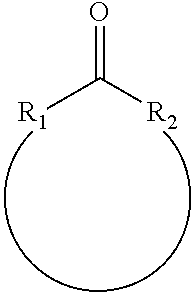Process for the oxidation of organic carbonyl compounds
a technology of organic carbonyl compounds and oxidation process, which is applied in the direction of organic compounds/hydrides/coordination complex catalysts, organic chemistry, physical/chemical process catalysts, etc., can solve the problems of considerable disadvantages in cost-effectiveness and safety aspects of use of peroxyacetic acid, and difficulty in scaling up
- Summary
- Abstract
- Description
- Claims
- Application Information
AI Technical Summary
Benefits of technology
Problems solved by technology
Method used
Image
Examples
examples
Reference Example A
Determination of the Water Uptake
[0295]The water uptake of the zeolitic materials is determined by water adsorption / desorption isotherms which were performed on a VTI SA instrument from TA Instruments following a step-isotherm program. The experiment consisted of a run or a series of runs performed on a sample material that has been placed on the microbalance pan inside of the instrument. Before the measurement was started, the residual moisture of the sample was removed by heating the sample to 100° C. (heating ramp of 5° C. / min) and holding it for 6 h under a nitrogen flow. After the drying program, the temperature in the cell was decreased to 25° C. and kept isothermal during the measurement. The microbalance was calibrated, and the weight of the dried sample was balanced (maximum mass deviation 0.01 weight-%). Water uptake by the sample was measured as the increase in weight over that of the dry sample. First, as adsorption curve was measured by increasing the...
reference example b
Determination of the Crystallinity
B.1 Crystallinity of Zeolitic Materials Having MWW Framework Structure
[0296]The crystallinity of the zeolitic materials according to the present invention was determined by XRD analysis. The data are collected using a standard Bragg-Brentano diffractometer with a Cu-X-ray source and an energy dispersive point detector. The angular range of 2° to 70° (2 theta) is scanned with a step size of 0.02°, while the variable divergence slit is set to a constant illuminated sample length of 20 mm. The data are then analyzed using TOPAS V4 software, wherein the sharp diffraction peaks are modeled using a Pawley fit containing a unit cell with the following starting parameters: a=14.4 Angstrom and c=25.2 Angstrom in the space group P6 / mmm. These are refined to fit the data. A linear background is modelled. Independent peaks are inserted at the following positions. 8.4°, 22.4°, 28.2° and 43°. These are used to describe the amorphous content. The crystalline conte...
reference example c
FT-IR Measurements
[0298]The FT-IR (Fourier-Transformed-Infrared) measurements were performed on a Nicolet 6700 spectrometer. The powdered material was pressed into a self-supporting pellet without the use of any additives. The pellet was introduced into a high vacuum (HV) cell placed into the FT-IR instrument. Prior to the measurement the sample was pretreated in high vacuum (10−5 mbar) for 3 h at 300° C. The spectra were collected after cooling the cell to 50° C. The spectra were recorded in the range of 4000 to 800 cm−1 at a resolution of 2 cm−1. The obtained spectra are represented in a plot having on the x axis the wave-number (cm−1) and on the y axis the absorbance (arbitrary units, a.u.). For the quantitative determination of the peak heights and the ratio between these peaks a baseline correction was carried out. Changes in the 3000-3900 cm−1 region were analyzed and for comparing multiple samples, as reference the band at 1880±5 cm−1 was taken.
PUM
| Property | Measurement | Unit |
|---|---|---|
| pressure | aaaaa | aaaaa |
| pressure | aaaaa | aaaaa |
| temperature | aaaaa | aaaaa |
Abstract
Description
Claims
Application Information
 Login to View More
Login to View More - R&D
- Intellectual Property
- Life Sciences
- Materials
- Tech Scout
- Unparalleled Data Quality
- Higher Quality Content
- 60% Fewer Hallucinations
Browse by: Latest US Patents, China's latest patents, Technical Efficacy Thesaurus, Application Domain, Technology Topic, Popular Technical Reports.
© 2025 PatSnap. All rights reserved.Legal|Privacy policy|Modern Slavery Act Transparency Statement|Sitemap|About US| Contact US: help@patsnap.com



